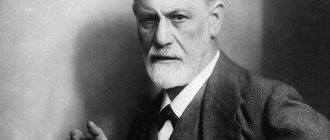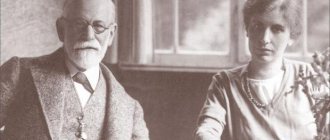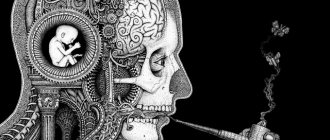“Libido” is one of the main concepts introduced into the world lexicon by the founding father of psychoanalysis, Sigmund Freud. During its existence in the cultural field, this word has acquired many meanings and interpretations. In modern psychology it is used as a synonym for sexual desire, but at the very dawn of psychoanalysis everything was much more complicated. We tell you how the role of libido has changed and what they propose to do with it now.
Attention! “Adult” content intended for persons over 18 years of age
How did Freud imagine the structure of the psyche?
The founder of psychoanalysis, Sigmund Freud, did not systematize his teaching about man.
He had his own scheme, but he preferred to demonstrate it in action, describing cases from practice. One of the best systematizations of Freud's theory is presented in the book “Dictionary of Psychoanalysis” by Jean Laplanche and Jean-Bertrand Pontalis. They showed that Freud used two topics (that is, diagrams), which are understood as the doctrine of the structure of the psyche.
In the first topic it was said that the psyche has two main authorities: the lower one is the unconscious, the upper one is the conscious. Between them there is an instance of censorship, also unconscious. The unconscious has the nature of energy, it is a reservoir of tensions (or drives).
The drives strive to break out and seize power, but censorship - its nature is rather mysterious - puts a barrier to them and forces the drives to come out in a roundabout way.
In the second topic, the psyche already consists of three levels, which are defined by the famous terms “It”, “I” and “Super-ego” (they are also called “Id”, “Ego” and “Superego”). “It” is the unconscious, and its nature is still the same: repressed drives. At the top level, Freud placed the “Super-Ego” - also an unconscious rather than a conscious authority. It is formed under the influence of upbringing and represents internalized images of parents - this is not just upbringing and a system of prohibitions, but also identification of oneself with parents, as well as the formation of one’s own ideal “I”.
Thus, in the second topic there are already two differently directed authorities - “It” and “Super-I”, and between them there is a layer of “I” that has no energy. The function of the “I” is to manage energy flows, respond to pressure from above and below. The “I” cannot do anything, but at the same time it is conscious. In this scheme, the “I” appears even more obviously than before as secondary and derivative relative to the unconscious.
Interestingly, the three-part topic is reminiscent of Plato's picture of the soul: he described it as a chariot with two horses, black and white, and a driver who drives them. In Freud, we also see two engines - conventionally black and conventionally white - and the “I” as the driver (note that Freud did not give the “Id” and “Super-Ego” an ethical assessment).
By the way, Freud’s theory about the instances of the mental apparatus is the first theory developed in philosophy, according to which the psyche consists of parts and is not something whole. Before Freud, the prevailing idea was that the soul is one (for example, Plato and Descartes believed this). But with the advent of the concept of the unconscious, it became easy to talk about parts. This idea has been developed in modern analytical philosophy of consciousness: for example, philosopher Daniel Dennett says that consciousness has no organizing center and its parts are in a state of self-organization (Freud did not make such far-reaching conclusions).
Definition
Translated from Latin, the term libido means “desire, passion, desire.” Usually the word “libido” refers to sexual attraction in general or to a specific person. However, initially this concept was much broader.
It was introduced by Sigmund Freud while working on his concept of psychoanalysis. According to Freud, libido is a special type of vital energy that underlies not only sexual desire, but also love: intergender love, for parents, for children and any other. Freud considered the source of this energy to be the Id (the human unconscious).
An important role in a person’s life is played by the ability to sublimate this energy, that is, transfer it from the sexual sphere to others: creativity, work, sports. His success and well-being depend on how well a person copes with this task.
Sigmund Freud's student Carl Gustav Jung viewed libido as energy in general, without linking this concept to sexuality. He noted its similarity to the Qi energy in Eastern teachings and even saw a certain mystical component in it.
What is repression and where do dreams come from?
Freud formulated new approaches to the study of the unconscious in his work “The Interpretation of Dreams” in 1900. In it, he came to the conclusion that the unconscious consists of repressed drives, and significantly expanded the idea of repression. Freud believed that not only what torments is repressed (as in the case of trauma), but also what a person does not want or cannot recognize in himself: aggression, envy, the desire to compete, a sense of superiority over others.
In the analysis of dreams, Freud proceeded from the fact that it is neither interesting nor necessary for a person to see something neutral in a dream: dreams arise due to the fact that latent desires accumulate in the psyche and require a way out. When they are satisfied in the form of dreams, the person calms down - this phenomenon in psychoanalysis is called fantasy realization.
However, direct satisfaction of desires does not occur in a dream: the primary impulse is transformed into an image that turns out to be acceptable.
The transformation process occurs through displacement, condensation and symbolization.
Freud called displacement the technique of substituting one object or image instead of another based on the principle of similarity: for example, a patient dreams of Uncle Joseph, but what he means is his colleague Joseph. Condensation is the ability of a dream to represent several repressed ones in one image. Symbolization - the appearance in a dream of an image devoid of sexual meaning, instead of a sexual image; this is exactly what has long become a common meme about Freudianism: if you dream of a long object, then it is the male genital organ, and so on.
To save, to be saved or not to touch?
Libido is a rather fragile structure. The speed of completing the puzzle and success can be affected by anything: stress, submitting an annual report, discussing the terms of a preferential mortgage, mistrust and fear of separation from a partner, or a broken leg. As a response to stress, libido can fluctuate both up and down.
Due to the stereotypes that society and popular culture establish regarding sexual behavior, many people may be dissatisfied with their type of attraction and believe that it needs to be changed. Sometimes these attempts can lead to even greater problems than in the “before” stage. Here are a couple of tips on what to do if you're not sure everything is as it should be.
Contact a specialist
A psychologist and sexologist will help you figure out what causes problems with desire and whether they exist. As we have already said, the problem may be psychological in nature, associated with trauma or chronic stress. An expert can help you get through it. If the problem lies in the physiological plane, you will be referred to an endocrinologist to prepare drug therapy. Remember that hormonal medications to correct libido must be prescribed by a doctor.
How are libido, the Oedipus complex and castration fear related?
Beginning with “Three Essays on the Theory of Sexuality” (1905), Freud moves on to interpret the unconscious as repressed libido. In the same work, he introduces the concept of infantile sexuality - the assertion that something like sexuality is characteristic of a person not only after puberty, but from birth (by the way, this idea was met with hostility by the medical community).
Might be interesting:
Anarchism + psychoanalysis = erotic revolution. Who did the representatives of German bohemia love and how?
Infantile sexuality, of course, is not similar to adult sexuality and is associated with the relationship between mother and infant. The first - oral - stage of libido development is experienced during the period when the baby suckles the breast and wants to have undivided possession of the mother. Then the child learns to regulate body functions and control his bowel movements (anal stage) - during this period the foundations of independence and stubbornness are laid. The third stage of sexual development is genital, which occurs during adolescence. Several years pass between the anal and genital stages of sexual development - during this time the child’s interest is transferred from his own body to the world around him.
Freud introduced the concept of the Oedipus complex later, but in fact already in “Three Essays” he completely prepared the ground for this idea, since the relationship between mother and child is also key to it.
The mother is always the first object to which the child feels attraction.
The child’s perception of it changes: at first it is only the mother’s breast, but over time a holistic image is formed.
Freud paints a very convincing diagram of a boy's growing up. As a child, he feels attracted to his mother and wants his mother to be with him all the time, to belong only to him. But at the age of one or two years, the boy begins to feel jealous of his father, who claims his rights to his mother.
Around this age, a boy discovers that women do not have penises. This discovery horrifies him: if someone doesn't have a penis, it means they can lose it too. The fear of castration is combined with jealousy of the father and attraction to the mother - and turns into fear of the father.
According to Freud's theory, in the normal development of a child, the Oedipus complex should move into the identification stage, where the child as a whole continues to want the same thing (to marry his mother), but now expresses it as a desire to grow up and become like his father.
By the way, Freud believed that during psychoanalysis the patient experiences towards the doctor the whole range of feelings that he experienced towards his father in childhood - this could be both love and hostility. Having met a psychoanalyst, a person seems to remember and experience feelings from childhood. Freud called this phenomenon transference. The psychoanalyst, in response to the transference, develops counter-feelings towards the patient - this phenomenon is known as countertransference. As a result, the patient and the psychoanalyst become not indifferent to each other.
Libido in sexology
Since in modern sexology libido is interpreted as sexual desire, we will focus our attention on this aspect.
Libido is a psychophysiological phenomenon. The strength of sexual desire is determined primarily by the action of sex hormones. In women it is progesterone and estrogens, in men it is testosterone. But psychological factors also have a huge impact on sexual desire.
There are specific differences between the libido of men and women, and they are quite significant. Therefore, we will consider them separately. Let’s look at what the severity of libido depends on and what factors influence it.
What did Freud think about the desire for knowledge and what does sublimation have to do with it?
Freud never wrote about epistemology and the theory of knowledge, since he had no interest in philosophy. Moreover, according to the theory of psychoanalysis, a person does not have any special desire for knowledge - he has a libido that has found a certain object. Freud introduces the concept of sublimation. This is what he calls the transfer of libido energy to non-sexual areas - primarily to the area of creativity and cognition.
Nevertheless, Freud's teachings contributed to the development of ideas that determined the face of epistemology in the twentieth century, for example, to the theory of object relations, which was formulated by Freud's student Karl Abraham. This theory is based on the thesis that the drive is primary and the object is secondary.
In psychoanalysis, the processes of cognition in a child are understood as follows: in the subject himself (that is, in the child), a certain drive operates, and around there are various, initially neutral objects. They receive a “load” as a result of the transfusion of energy from a source in the subject. Having received energy from the outside, the object becomes charged, “loaded,” interesting, not indifferent, and necessary. It is curious that from the point of view of psychoanalysis, these qualities are still not properties of the object, since they remain associated with the action of the subject. So we can say that the psychoanalytic theory of interaction between the subject and the world is subjectivist.
Freud begins with the fact that the infant is not aware of the difference between the “I” and the world. He has no definite sense of his own body, no body schema.
A newborn baby cannot yet move independently, so he does not have the feedback between movements and body sensations that is characteristic of an adult. All he has are sensations of pleasure and displeasure. His natural tendency is to place everything that is pleasurable inside himself, and everything that causes discomfort to be external (later this will become important for adults in our typical cognitive distortions).
The baby is busy constructing his surrounding world. He needs to separate the world from himself, and at first he does this very inaccurately. Naturally, the whole world is created and relied upon by him around his own drives. The main attraction of the baby is the satisfaction of hunger, the main object is the breast. The breast is perceived as a good sorceress that appears when the baby wants it. It seems to him that he can control her through the “omnipotence of thoughts” - which Freud attributed to infants (and primitive people). All other objects of the world are also created by the infant subject only through some relation to his own drives.
Apparently, Freud somewhat exaggerated the subjectivity of the world created in this way. For example, from his theory it follows that the baby will not pay attention to the rattles above the crib and to the mother's face, since they do not satisfy his drives. But observations of babies show that this is not so: children willingly focus their gaze on rattles, smile at their mother, and in general, any person - especially one who is slightly older than a newborn - has a selfless interest in the world that is not related to needs. Even animals have a semblance of such interest; ethologists call it search behavior.
The key to happiness
Nowadays "libido" is used as a synonym for sexual desire. It describes a person's desire and ability to have sex. If Freud considered libido a physiological need on a par with hunger, then today it is part of the human motivational system.
And, of course, this is not ephemeral energy coursing through the body. Libido is a whole set of sex (and not only) hormones that are responsible for human sexual behavior, as well as brain reactions that are responsible for reading sexually relevant signals.
The principle of libido action can most easily be compared to solving a Rubik's cube. For the puzzle to be considered solved, all the colors on each side must match. Libido works the same way; all factors need to come together:
Sexually relevant signals are read The brain selects from the many signals it receives those that are associated with sex. This could be your partner's touching, kissing, movements or appearance that you perceive as sexual.
Hormones are released A whole cocktail of pituitary hormones, sex hormones and neurotransmitters enters the bloodstream, which alerts the body to active action.
Circumstances approved by the brain There is such a thing as nonconcordance, Emily Nagoski talks about it in detail in the book “As a Woman Wants.” This is a situation where the genital response that signals a person's arousal does not coincide with what he is actually thinking. In men, according to research results, the coincidence of the genital response with arousal “in the brain” is 50%, and in women it is only 10%.
For some this process of assembling the puzzle is easier, for others it is more difficult. It largely depends on sexual temperament - the characteristics that the surrounding culture imposes on a person’s sexual behavior.
What are projection and rationalization?
The concepts of projection and rationalization are also associated with epistemology and the theory of knowledge. Both projection and rationalization indicate that we often see reasons for our feelings and actions that have nothing to do with the real reasons.
In near-psychoanalytic speech, projection refers to the tendency of people to attribute to others qualities that they themselves have. But Freud understood projection more broadly and deeply. From his point of view, projection is close to the concept of load - this is a person’s tendency to see the causes of his feelings in external objects, while we ourselves load the objects with our own relationships.
For example, a person woke up for some reason in a bad mood, and it seems to him that his wife, child, or dog are to blame. And the next day he wakes up and everything is fine with him - and now he has a beloved wife, a smart child, and a wonderful dog.
Another example: we feel hostility towards a person for unconscious reasons unknown to us, but since we feel the need to somehow explain to ourselves the feeling that has arisen, it begins to seem to us that this person himself is hostile to us, and we are only responding to him. This is how we unconsciously place the reasons for our feelings in the world around us. (By the way, projection is an effective tool for understanding delusions in paranoid schizophrenia. This is a case where the primary disturbance appears to be pathological affect, an acute experience of fear or wariness, probably due to biochemical disturbances in the brain. However a person must somehow explain to himself his condition: if there is fear, then something dangerous is happening. This is how the delusion of persecution is born.)
Rationalization is a person's tendency to explain his actions by internal motivation rather than by external reasons.
Suppose a person under hypnosis was given a delayed suggestion, saying: “Five minutes after you wake up, you will jump and clap your hands.” The man wakes up and five minutes later jumps up, claps his hands and exclaims something like: “I remembered where I put the keys!” The person jumped because of a suggestion, but does not know about it and therefore feels the need to explain his action to himself (the person comes up with the reason, of course, unconsciously).
Sublimation of sexual energy
Sexual libido is energy aimed at satisfying sexual needs. If for some reason it is impossible to satisfy the instinct, a person subconsciously begins to sublimate sexual libido - redirects it in another direction, transforms it into energy of a different level.
You can sublimate energy in energetic sports (running, wrestling, football, boxing), in various forms of art (music, painting, sculpture). Many people with problems with their sex life throw themselves into work, finding in this a way to suppress and redirect their sexual energy into business and achieve great success.
Sexual attraction is natural, directed towards health, spiritual development, and social and personal relationships. The impossibility of full satisfaction can cause aggression, rudeness, and deviant behavior in a person. To avoid such consequences, you need to learn to sublimate energy into a safe and useful channel.
Regardless of how libido is viewed (sexual desire, focus on specific tasks in life, or love for others), its proper development leads to spiritual and personal growth, success in career and family life. In cases of severe psychosis, neurotic conditions and depression, many psychologists find the root of the problem in the disruption of the development of this instinct. Only a qualified specialist will be able to help with the problem that has arisen, teach a person to control his instincts and direct energy in the right direction to achieve a high level of self-development, social, personal and sexual life.
Author of the article: Ermakova Marina Leonidovna, practical psychologist, specialist in developmental psychology
What is the pleasure principle and the reality principle, and what does fantasy have to do with it?
According to the pleasure principle, every desire should be satisfied immediately. Fantasy serves to comply with this principle. From Freud's point of view, fantasy is an unconscious mechanism that is triggered by drive. Under no circumstances should one assume that a person decides what to fantasize about. Fantasy, like drives, is a physiologically conditioned and compulsory thing.
The principle of reality is associated with the fact that over time the child realizes the opportunity to satisfy desires not only fantasy, but also in reality. However, to do this, he needs to overcome certain difficulties, which means sacrificing the immediate satisfaction of desire. This is how the child gradually learns to act in reality.
In adults, the reality principle replaces the pleasure principle. As a consequence, the pleasure principle withdraws into fantasies, the drives stimulate fantasy ways of satisfying them, and the conscious “I,” fully imbued with the reality principle, uses fantasies as material for choosing goals.
Example: let's say a person is hungry. This need arises at the physiological level, but then the imagination begins to sort out possible ways to satisfy hunger: go to an expensive restaurant, to a simple cafe, to a buffet, to home, to cook soup, to make a sandwich.
From the point of view of fantasy, Freud emphasizes, all options are equivalent, because it has no idea of obstacles. Taking into account obstacles is a matter of the reality principle. The reality principle should weed out those options that seem unacceptable (for example, going to an expensive restaurant or making a unhealthy sandwich). Already at the conscious level, the “I” may hesitate for some time between several acceptable options, but then it makes a decision and transfers it to the level of an action program.
Dualism of drives
The contrast between sexual drives and self-drives (drives for self-preservation). Freud describes this phenomenon using the example of feeding a baby, an example of oral, sexual attraction. When the baby is hungry, he begins to scream, he is given the breast, the baby begins to eat greedily and slowly becomes full, discharge occurs. He satisfies his desire for self-preservation, satisfies his hunger. At the time of feeding, the baby also experiences pleasure from the sucking process. It turns out that the very pleasure of the process is separated from the satisfaction of the drive for self-preservation, from hunger. Thus, the oral sexual desire is distinguished from the drive for self-preservation.
Why did Freud need Thanatos and how does it explain the death drive?
In his next important theoretical work, the book Beyond the Pleasure Principle (1920), Freud had to revise some of the provisions of his theory.
The need to reform the theory arose in connection with the consequences of the First World War. The war neuroses that arose in combat veterans could not be explained through disturbances in the organization of libido, which were used to explain ordinary neuroses.
Freud's thoughts received a new stimulus when he saw a one-and-a-half-year-old child playing: he was throwing a reel tied to his hand by a thread. When the coil disappeared from the child’s field of vision, he shouted: “There!”, and pulling the coil towards himself, he stated: “Here.” Freud saw in this game a training in the general ability to be deprived and get used to the absence of an object, and in the reel - a symbol of treasure, from the mother to one’s own life.
Using this analogy, Freud explained the origin of war neuroses in people returning from the First World War: in his opinion, their ability to experience pain was not sufficiently trained. These people were not mentally prepared for the horrors they endured and for death in war.
In the same theory, Freud adds one more to the list of drives - the drive for peace. Freud associated it with the death drive, or Thanatos. Like libido (or Eros), Thanatos can be directed inward or outward—it is nirvana and aggression, respectively. Self-directed Thanatos is inextricably linked with self-directed Eros (or self-love), and outward-directed Thanatos is associated with outward-directed Eros (love of an external object). In fact, the doctrine of Thanatos became a continuation of the idea of narcissism, by which Freud understood self-love (the work of the libido directed towards the Self-object).
The idea of narcissism generally comes into contact with the most important philosophical teachings; it is not for nothing that Freud also uses the expression “principle of nirvana” with a reference to Buddhism for it. A very important skill for a person throughout his adult life is to have a positive attitude towards existence, to appreciate it in itself. Unfortunately, very often a person acquires this skill only in adulthood, when there is little existence left, and sometimes he does not acquire it at all.
Sexual instinct in men
A man's libido is a sexual desire that drives him on a subconscious level. Many people confuse the concepts of libido and potency, although the former means attraction to a woman at the level of instinct, regardless of whether the man can perform sexual intercourse or not. Potency means the ability to physically perform this act.
As a rule, in adolescence and young adulthood, libido in men is increased. Sexual desire forces a man to have affairs, satisfying the need for sex with as many partners as possible. There are frequent cases of family breakdown due to frequent infidelities of a spouse who has an increased libido, and the wife is not ready to satisfy her husband’s lust in all its manifestations.
Over the years, libido levels may decrease; the reasons can be psychological, hormonal, stressful, and others. Typically, androgen deficiency appears by age 45, but testosterone levels begin to decline after age 25.
Problems of decreased libido, which have caused discord in the family, are solved depending on the factors that provoked them. This could be hormonal imbalance, poor diet, frequent stress and fatigue, alcoholism, or psychological reasons. You can increase a man’s libido by curing a specific disease and improving the psychological situation in the family.
How did Freud explain the prohibition on incest and what kind of relationship did he have with his mother?
In his later works, Freud turned to the analysis of society and culture - he wrote about them in the books “Totem and Taboo” (1913), “Mass Psychology and Analysis of the Human Self” (1921), “Discontent with Culture” (1930).
The book “Totem and Taboo” can be classified as “psychoanalytic fiction,” for which Freud was rightly criticized. The work contains some very outlandish ideas that are easy to question, such as the suggestion that the common human feeling of parental guilt in many cultures stems from the fact that in primitive times a group of brothers allegedly ritually murdered their father. Freud also connects the persistence of certain taboos in culture with this.
However, the main theme of this book is avoiding incest. Freud interprets the traditions of exogamy from this position, adding to his usual theme of incest of children and parents also the theme of avoiding incest between a man and his mother-in-law.
The libido-based relationship between parents and children is not such an extravagant Freudian fantasy as it may seem to people far from psychoanalysis.
Unfortunately, the transfer of mother's libido to the child is a fairly common occurrence. Let's give an example. When a person is in love, it seems to him that the object of his love is better than everyone else, and the object is described in superlatives. When a young man falls in love with a girl, it seems to him that she is the most beautiful of all, the most wonderful of all - this is natural, since the object of libido is the girl. As for the girl, she often treats her chosen one calmly and can see his shortcomings. But when a girl looks at her child, it seems to her that he is the best, most beautiful and smartest - she overestimates not her partner, but her child. The girl relates objectively to her partner, but subjectively to the child, so that the object of her libido is the child.
Later, Lacan discussed this feature of the relationship between mother and child, talking about how important it is for the father to intervene in this relationship. Modern psychotherapy also adheres to the idea that a too close relationship with the mother is undesirable. And since the classical two-parent family form is in crisis, psychotherapists will sooner or later have to develop teachings on how best to raise fatherless children while preventing libidinal transferences from the mothers.
By the way, it is known that Freud’s mother treated him with delight, which played a big role in the early development of his character. His character developed strong. But if Freud had been weaker by nature, his mother could have subjugated him.
Hatred
As the attitude towards an object, hatred is older than love, it corresponds to the initial rejection of the irritating external world on the part of the narcissistic self . Both Freud and Melanie Klein argued that the object is born in hatred. What does it mean? While the object is present near the infant, it is as if he does not notice her as an object. And in the words of Donald Winnicott , the mother is the environment. But as soon as the mother goes away and abandons her baby, at that moment the baby discovers her as an object. Therefore the object is born in hatred. As an expression of displeasure reactions caused by objects, hatred is constantly in close connection with the ego's drives for self-preservation, and therefore the drives of the ego and the sexual drives can enter into a contradiction that repeats the contradiction between hatred and love. If the drives of the ego dominate the sexual function, as for example at the level of the anal-sadistic organization, then they also impart the properties of hatred to the goal of the drives. Hatred is the opposition of love.
What did Freud think about the existence of taboos in society?
In subsequent works, Freud continued to develop the social aspects of his theory, moving from the family to the theme of society. In the book “Psychology of the Masses” he raises questions about the mechanisms of mutual infection in the crowd.
From Freud's point of view, the crowd cannot have reason, it does not weigh the pros and cons, and is also capable of colossal achievements and equally colossal destruction. An individual person in a crowd loses the ability for critical thinking and becomes just a dependent cell of an entire organism, which is many times stronger and more unreasonable than each person. In a crowd, a person seems to lose his head and also becomes much stronger and much more unreasonable than his usual self.
In this part, Freud repeated the ideas formulated by Gustave Le Bon in his book The Psychology of Crowds. However, Freud saw his task as going further and describing the state of a person in a crowd from the point of view of psychoanalysis and the theory of the “Super-Ego” - the authority of conscience, formed as a result of the internalization of the image of the father.
In a normal state, a person lives under the burden of conscience and suffers from it. At the same time, it is conscience that gives a person the opportunity to stop and think before acting; It is the ability to weigh the pros and cons that gives a person the opportunity to act freely and autonomously.
In the crowd, a person refuses the internalized “Super-Ego” - he, as it were, returns to the state of a child and delegates his “Super-Ego” to the one who in the crowd takes on the role of “father” (leader, commander, leader).
Freud, being an extreme anti-clerical, tried to bring the church under this theory, but encountered difficulties of a theoretical nature; after all, the church is not an enthusiastic crowd. Nevertheless, Freud saw in the church the beginning of mass development and said that the priest or the figure of God takes on the form of the “Super-Ego” in it.
Representative(s) of drive
- Representation is the mental expression of endosomatic excitations. Endosomatic is an arousal that exists inside the body that creates a representation at the psychic level;
- Affect [quantum of affect] is a qualitative expression of the amount of drive energy and its varieties;
- An emotional-affective state (German psychology) is a pleasant or unpleasant, vague or distinct state, manifested in a general mental tone or in a strong energy discharge.










